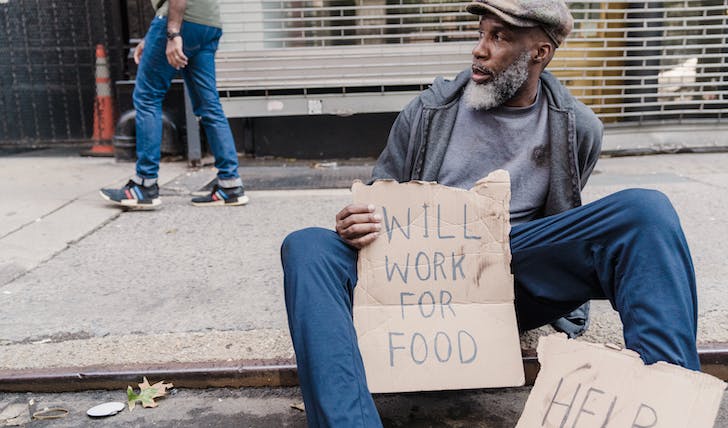
Question Time: Why Americans Are So Poor in a Country So Rich

In a nation celebrated for its colossal wealth and technological advancements, the persistence of poverty presents a paradox. The United States, often viewed as the land of opportunity, grapples with a staggering poverty rate. Matthew Desmond, a Pulitzer Prize-winning author, dives into this conundrum in his revealing book, “Poverty, by America.”
In the book, Desmond highlights an unsettling truth: Despite America’s affluence, a significant portion of its population remains impoverished.
The Stark Reality of American Poverty
Desmond points out that the poverty rate in the U.S. has stubbornly hovered around 21% for the last fifty years. This statistic is alarming, especially considering the nation’s global economic stature. The question arises: Why, in such a prosperous country, do so many continue to struggle with poverty?

IA / Unsplash / The poverty rate in the U.S. has been hovering over 21% for the past half-century, Desmond suggests.
According to Desmond, the root of the problem lies within the very fabric of American society. This is not just about the lack of resources. It is about how those resources are distributed and who has access to them. The wealth gap, systemic racism, and unequal educational opportunities all play a role in perpetuating poverty.
Wealth Inequality
One of the most significant factors is the ever-widening wealth gap. The rich continue to accumulate wealth at an astonishing rate, while the poor are left with crumbs. This disparity is not just a matter of individual failure but a systemic issue that needs addressing.

Pixabay / Pexels / The best-selling author argues that the issue lies among “us” as he suggests that poverty is ‘by’ America and not ‘in’ America.
Racial inequality is another critical aspect. Historically marginalized communities, especially African Americans and Hispanics, face higher poverty rates. This is a consequence of systemic racism that affects everything from housing to employment opportunities.
Similarly, education is often touted as the key to escaping poverty. However, in many low-income neighborhoods, schools lack the resources and support to provide quality education. This creates a cycle where poverty begets poverty, trapping generations in the same struggle.
The Role of Government Policies
Government policies play a pivotal role in either alleviating or exacerbating poverty. Tax policies, welfare programs, and healthcare access significantly impact the lives of the impoverished. Desmond argues that many of these policies, rather than lifting people out of poverty, often entrench them deeper.

Weber / Pexels / Desmond suggests that with concerted efforts and systemic changes, poverty can be reduced significantly.
Plus, the welfare system in the U.S. is often criticized for its inefficiency and inadequacy. Rather than providing a safety net, it sometimes acts as a trap, disincentivizing work or improvement due to the fear of losing benefits.
The Myth of the American Dream
The American Dream promotes the idea that anyone can succeed through hard work and determination. While inspiring, this notion often overshadows the structural barriers that prevent many from achieving economic stability.
Reforming policies to make them more equitable can have a profound impact. This includes reforming the tax system, improving the welfare system, and ensuring access to quality education for all.
Finally, the lack of universal healthcare in the U.S. is another factor contributing to poverty. As it stands, medical expenses can be catastrophic for low-income families, pushing them further into financial despair.
More in Buzz
-
`
Sam Bankman-Fried’s Secret Celebrity Network Exposed
In the glitzy world of cryptocurrencies, where fortunes can be made and lost instantly, having connections to the stars can make...
November 29, 2023 -
`
Are Rare Earth Elements Really So Rare?
When we hear the term “rare earth elements,” our minds often conjure up images of elusive and scarce materials. After all,...
November 20, 2023 -
`
Exploring America’s Top Tier Hotels
For those who crave the finer things in life, the United States offers a treasure trove of luxurious hotels that elevate...
November 19, 2023 -
`
Where Does Elon Musk Live? Let’s Find Out!
Elon Musk, the billionaire entrepreneur and visionary behind Tesla and SpaceX, is known for pushing the boundaries of technology and innovation....
November 10, 2023 -
`
The Origin of Elon Musk’s Feud With Bill Gates
In the world of tech titans and billionaire visionaries, it’s not uncommon for rivalries and feuds to develop. One of the...
November 1, 2023 -
`
Wall Street Downgrade VS. Upgrade: Which One Is Better for Your Money?
“Bad news sells.” It is an age-old adage we have all heard before. In the world of finance, the principle often...
October 28, 2023 -
`
Guitar Smashed By Nirvana’s Kurt Cobain Sells for Nearly $600k!
In the world of rock ‘n’ roll, legends are born from the music and the artifacts left behind. One such artifact,...
October 21, 2023 -
`
Dwayne “The Rock” Johnson’s Plastic Surgery Journey
Dwayne Johnson, globally celebrated as “The Rock,” is synonymous with wrestling and Hollywood stardom. With a physique chiseled from relentless workouts...
October 10, 2023 -
`
The Most Expensive Things Owned By Brad Pitt
Brad Pitt, one of Hollywood’s most iconic and influential actors, has amassed fame and fortune and an impressive collection of extravagant...
October 3, 2023















You must be logged in to post a comment Login